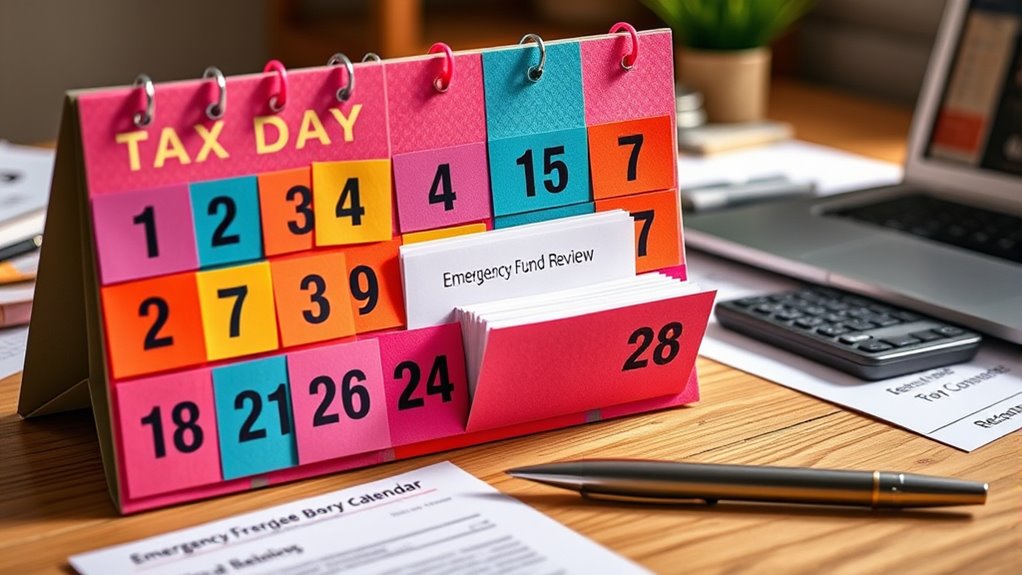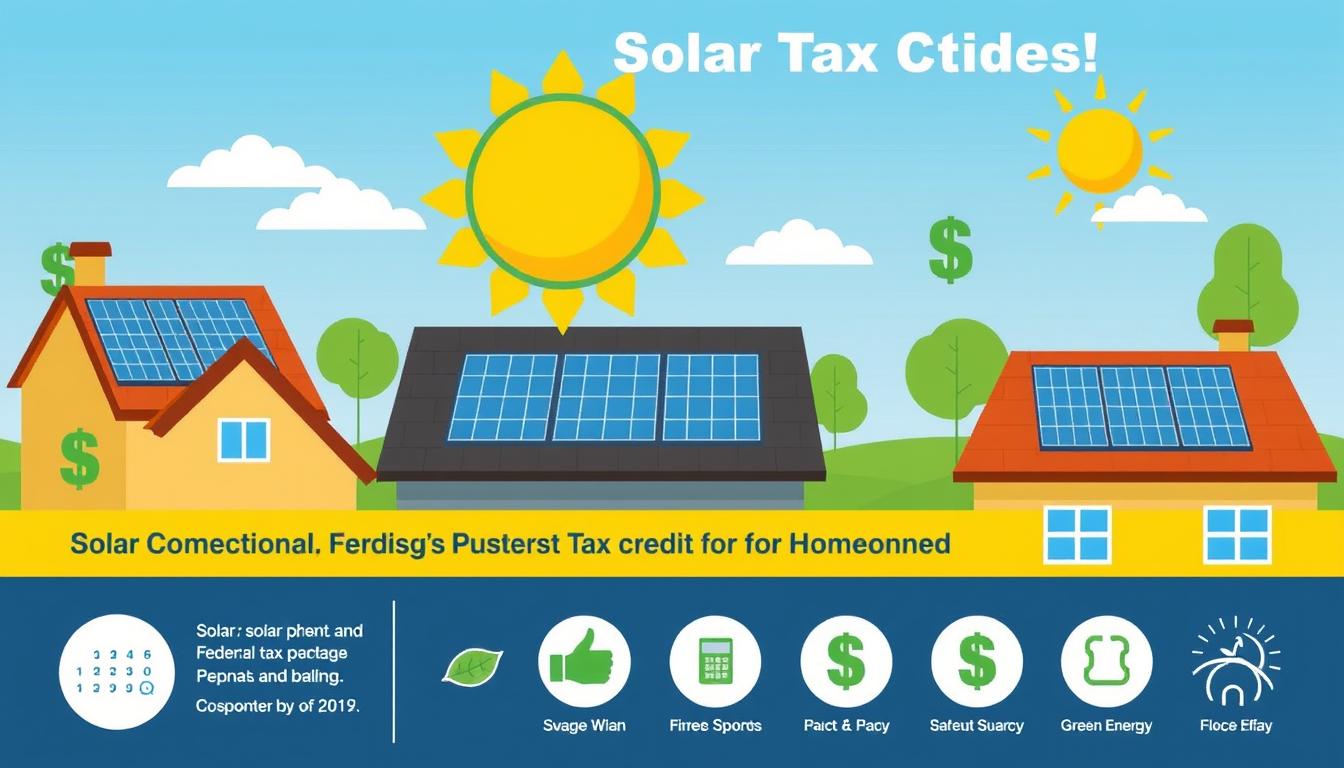A 50-day tax prep countdown helps you stay organized and on track. Start by setting clear goals, gathering financial documents, reviewing last year’s return, and creating a calendar with key deadlines. Break down tasks into manageable steps, like updating software and planning expenses. Tracking progress and meeting deadlines reduces stress and guarantees compliance. Keep in mind, following this guide will help you prepare thoroughly — if you want to learn essential tips, keep going.
Key Takeaways
- The calendar guides early goal setting, document gathering, and deadline tracking to ensure timely tax preparation.
- It emphasizes reviewing last year’s return and creating a visual schedule for key tax deadlines.
- It covers software updates, expense planning, and leveraging tax credits to maximize deductions.
- The calendar includes steps for preparing and filing required forms like 1099s, W-2s, and payroll documents.
- It promotes ongoing record organization, digital security, and staying informed on tax law changes over 50 days.
Day 1: Set Your Tax Preparation Goals

Why is it essential to set your tax preparation goals on Day 1? Starting early helps you complete your tax returns on time and reduces last-minute stress. Using tax software effectively relies on realistic goals, guaranteeing you stay organized and meet IRS regulations. Clear goals allow you to align your resources efficiently, improving overall productivity and service quality. Establishing specific, measurable, and timely objectives fosters transparency and strengthens client relationships. Proper goal management prevents overwhelm and keeps your team focused. Frameworks like templates and SMART criteria help you track progress and stay on course. By setting these goals from the start, you ensure your tax prep process is structured, compliant, and geared toward achieving your business and client satisfaction objectives. Additionally, setting goals early reduces the risk of overlooked details and last-minute errors, ensuring a smoother workflow throughout the tax season. Incorporating projector technology principles such as clear visual goals can further enhance your planning and execution strategies.
Day 2: Gather Your Financial Documents

Are you ready to start organizing your financial information? Gathering your documents now guarantees a smoother tax season and helps you stay compliant with tax law. Keep these key items secure to protect your personal information:
Getting organized now makes tax season easier and keeps your personal information secure.
- Personal ID, Social Security numbers, IRS notices, and last year’s return
- Income records from W-2s, 1099s, and other sources like rental or investment income
- Expense documentation, including receipts for childcare, business costs, home ownership, and charitable donations
Organize everything in a safe spot, whether digital or physical, to prevent document breaches. Having all relevant documents ready not only streamlines your filing process but also ensures you claim all eligible deductions. Additionally, understanding how electric bikes and generators work can be beneficial if you’re considering eco-friendly transportation options or alternative energy sources like bike generators. Proper document security and thorough preparation are essential for stress-free tax filing.
Day 3: Review Last Year’s Tax Return

Reviewing your last year’s tax return is a practical step that sets a solid foundation for your current filing. It helps identify potential tax deductions and ensures you’re prepared for the upcoming filing deadline. By examining your previous return, you can spot errors, verify personal details, and anticipate necessary documents. Use this table to streamline your review:
| Element to Check | Why It Matters | Action Needed |
|---|---|---|
| Income sources | Confirm all income is reported | Cross-reference with 1099s and W-2s |
| Deductions and credits | Maximize benefits and ensure eligibility | Review receipts and documentation |
| Personal info | Prevent delays or issues | Verify SSNs and bank details |
Additionally, reviewing your previous tax return can help you identify any overlooked deductions or credits, allowing you to claim all eligible benefits this year. This review helps you prepare for any changes, optimize your tax deduction opportunities, and meet the filing deadline confidently. Incorporating knowledge about tax law updates can further enhance your understanding of potential benefits.
Day 4: Schedule a Meeting With Your Financial Advisor

Scheduling a meeting with your financial advisor early in the tax year can considerably enhance your overall tax planning strategy. It allows you to proactively manage your tax liability and refine your investment strategies for better results. Early meetings help you understand how your income affects your marginal federal tax bracket and identify opportunities to optimize deductions and credits. By collaborating with your advisor, you can align tax strategies with your financial goals, ensuring your investments are tax-efficient. This proactive approach gives you time to adjust your financial behaviors and maximize benefits before year-end. Additionally, understanding the importance of tax-efficient investment strategies can further optimize your financial outcomes.
Day 5: Create a Tax Calendar With Key Deadlines

Creating a tax calendar helps you stay on top of important deadlines and avoid last-minute stress. Use visual tools like calendars or apps to mark key dates, making them easy to track. Don’t forget to set reminders that prompt you in advance, so you have plenty of time to prepare everything needed. Being aware of federal and state tax filing deadlines in 2025 ensures you won’t miss critical dates that could lead to penalties or interest. Incorporating sound design techniques into your planning can help you create a clear and effective schedule, reducing the chance of oversight.
Highlight Critical Dates
Keeping track of tax deadlines is essential to prevent penalties and guarantee timely submissions. Recognizing key dates helps you incorporate tax shelter strategies and plan estate planning effectively. Mark these critical deadlines:
- January 31, 2025: Send out W-2s and 1099-NEC forms.
- March 15, 2025: File S corporation, LLC, and partnership returns.
- April 15, 2025: Submit individual, C corporation, estate, and trust filings.
- October 15, 2025: Final extension deadline for individual returns.
- December 31, 2025: RMDs from retirement accounts are due.
Staying aware of these dates ensures smooth compliance, maximizes tax planning opportunities, and keeps your financial strategy on track. Use this calendar to avoid costly oversights.
Use Visual Tools
Using visual tools to manage your tax deadlines can substantially improve workflow efficiency by providing a clear, centralized view of all important dates and tasks. Visual tax calendars help you track multi-year deadlines, compliance tasks, and jurisdiction-specific filings, ensuring nothing slips through the cracks. Integrating automation updates deadlines automatically based on tax law changes, reducing manual errors. Tools like Thomson Reuters ONESOURCE or Excel templates streamline workflows by updating statuses and sending reminders. Incorporating visual elements such as color coding and icons makes it easier to prioritize tasks and monitor progress. While virtual reality isn’t yet common in tax prep, it could revolutionize how teams visualize workflows, reducing environmental impact by minimizing paper and physical meetings. These visual tools foster team coordination and keep everyone aligned with key deadlines. Furthermore, using a comprehensive compliance and tax calendar software ensures that deadlines are consistently met across multiple jurisdictions through automatic updates and alerts, significantly reducing the risk of late filings.
Set Reminders Effectively
Setting effective reminders is essential for staying on top of your tax deadlines and avoiding costly penalties. Proper reminders ensure you meet key dates for tax deductions, estimated payments, and IRS audit preparations. To maximize your efforts:
- Use multiple alerts (e.g., one month, one week, one day before each deadline).
- Link reminders to related tasks like gathering documents or transferring payments.
- Categorize them by tax type to prevent confusion.
- A well-organized reminder system can significantly improve your compliance rate, especially during busy tax seasons. Sync these alerts across devices and integrate them into your digital calendar or task management tools. This way, you won’t miss critical deadlines, especially if they fall on weekends or holidays. Well-timed reminders keep you proactive, reducing last-minute stress and helping you avoid penalties or missed tax deductions. Properly setting reminders is your best defense against overlooked IRS audit triggers.
Day 6: Organize Receipts and Invoices

Organizing receipts and invoices efficiently can save you time and reduce stress come tax season. Start with receipt archiving by using physical filing systems like labeled folders, envelopes, or expanding files sorted by expense categories such as business, medical, or charitable expenses. Digitally, scan receipts and save them as PDFs, which makes storage and retrieval easier. Utilize receipt management apps for automatic capture, categorization, and syncing with your accounting software. Combine both physical and digital methods to create reliable backup strategies—saving digital copies in cloud storage and on external drives protects against data loss. Regularly organize receipts at set intervals, like weekly, to prevent backlog. Clear, consistent organization simplifies tax filing, maximizes deductions, and ensures you’re prepared for audits. Additionally, understanding proper file organization methods can enhance your overall tax prep efficiency.
Day 7: Audit Business Expenses to Maximize Deductions

Auditing your business expenses is a crucial step to guarantee you’re claiming all possible deductions and staying compliant with IRS regulations. By reviewing your expenses, you can identify overlooked deductions, such as employee reimbursements or cryptocurrency auditing costs, which could lower your taxable income. Proper documentation and accurate records are essential to substantiate your claims and prevent red flags during an audit. Regular audits also help ensure your records align with tax laws, avoiding penalties. Recognizing trust issues can also help you identify areas where your record-keeping might be lacking or inconsistent, further safeguarding your audit process. Doing these checks now maximizes your deductions and keeps your business audit-ready.
Day 8: Review Your Income Projections for Next Year

Reviewing your income projections helps you spot future revenue trends and adjust your plans accordingly. It also shows how changes in income could impact your taxes next year. Staying on top of these projections guarantees you’re prepared for any financial shifts ahead. Being aware of the best heat pump options can also help you make energy-efficient choices that reduce costs over time.
Projected Revenue Trends
As you prepare for next year’s taxes, understanding current revenue trends can help you better project your income and tax liability. Tax policy adjustments, inflation-related standard deduction increases, and revenue forecasting by agencies like the CBO all influence income expectations. Despite concerns over IRS staffing cuts, tax receipts remain strong, with individual income and payroll taxes rising over $100 billion from last year. Local revenue, like property taxes, continues to grow modestly, while some streams, such as franchise payments, decline. Revenue trends from tax firms also indicate continued industry growth, which can impact your income outlook. Staying aware of these factors guarantees your projections reflect the current fiscal environment. Additionally, monitoring angel number trends can offer insights into upcoming positive changes and opportunities in your financial journey.
Future Tax Impact
Understanding how your projected income will impact your taxes is essential for effective planning. Conducting a tax rate analysis helps you identify potential increases in marginal tax brackets due to income volatility, allowing you to adjust strategies proactively. Reviewing income projections with current data and anticipated changes in laws ensures accuracy, so you can spot potential liabilities early. Comparing projections against similar taxpayers provides a realistic benchmark, helping you refine your estimates. Incorporating multiple methods, like analyzing historical patterns and scenario planning, creates a thorough view of future tax impacts. This foresight enables you to time income recognition, make strategic deductions, or consider conversions, ultimately minimizing your tax burden and optimizing your financial outcome for next year. Accurate projections also help you prepare for any unexpected changes in tax laws that could affect your liability.
Day 9: Analyze Your Current Tax Bracket

Knowing your current tax bracket is essential for effective tax planning, as it determines the rate at which your last dollar of income is taxed. Your tax bracket depends on your taxable income and filing status, with income thresholds setting the boundaries for each rate. For example, in 2025, single filers pay 10% on income up to $11,925, then higher rates apply as income increases. Understanding your tax bracket helps you see how much of your income is taxed at each level and guides your strategies for deductions or additional income. This knowledge can also help you estimate your potential tax liability and identify opportunities to lower it through deductions or credits. Being aware of tax bracket thresholds can help you plan year-round to optimize your tax situation.
- Match your taxable income with the correct income thresholds for your filing status
- Identify your marginal tax rate to plan for extra income or deductions
- Keep track of income ranges to avoid crossing into a higher tax bracket
Day 10: Update Your Financial Software and Tools

Have you updated your financial software and tools lately? Keeping your software current guarantees you’re compliant with the latest tax laws, including cryptocurrency taxation rules and international reporting requirements. Updates often include new forms, changes to deductions, and enhancements that improve accuracy in tracking income, expenses, and deductions. They also fix bugs, boost security, and add features like automated data import, simplifying your tax prep. With cryptocurrency gains or international income, using updated tools helps ensure proper reporting and avoids errors. Regular updates from providers like TurboTax or H&R Block keep your software compatible with the latest operating systems. Remember to back up your data before updating, so your tax information stays safe. Staying current allows you to leverage all the benefits of improved accuracy and streamlined filing.
Day 11: Identify Opportunities for Accelerating Expenses

Updating your financial tools helps guarantee accurate and compliant tax filings, but proactively planning your expenses can further improve your tax position. Identifying opportunities for accelerating expenses lets you take advantage of tax deduction strategies by adjusting expense timing. This approach reduces your taxable income for the current year and provides immediate tax savings. Consider prepaying deductible expenses like rent, insurance premiums, or professional fees to maximize deductions now. Understanding taxable income and deductions is essential for effective tax planning.
- Prepay property taxes or subscriptions before year-end
- Purchase equipment or make business-related payments early
- Contribute to retirement accounts or donate appreciated assets
Using expense timing strategically, you can control when deductions occur, optimize your tax outcome, and potentially improve cash flow. Always ensure these expenses comply with IRS rules to avoid issues.
Day 12: Explore Tax Credits and Incentives

Today, it’s important to explore the various tax credits and incentives available to small businesses. These programs can substantially reduce your tax liability and encourage investments in energy efficiency and growth. Understanding which credits you qualify for helps you maximize your savings and stay ahead during tax season. Tax credits can be refundable, partially refundable, or nonrefundable, so knowing the type of credit is essential for effective planning.
Available Tax Credits
Are you aware of the various tax credits available to help reduce your tax burden and support your financial goals? Knowing about these credits allows you to maximize your tax benefits through deduction optimization and make sure you qualify for the right ones. For example, the Earned Income Tax Credit (EITC) can provide up to $8,046, depending on your income and family size. The Child Tax Credit offers up to $2,200 per child, with some states adding extra benefits. The Premium Tax Credit helps lower health insurance costs and is refundable, meaning you can receive it even if you owe no taxes. In 2025, the Child Tax Credit increases to $2,200 per child, with a maximum refundable amount of $1,700. – Earned Income Tax Credit (EITC) for low-to-middle-income families – Child Tax Credit and state-level supplements – Health insurance subsidies through the Premium Tax Credit
Incentives for Small Businesses
Looking to grow your small business? Incentives for small businesses, like the Work Opportunity Tax Credit (WOTC), motivate hiring from targeted groups, promoting workforce diversity and stronger employee benefits. Extended through 2025, WOTC offers up to $2,400 per new full-time hire facing employment barriers, supporting corporate sustainability by fostering inclusive hiring practices. In 2025, new tax credits further assist with employee training and sustainability initiatives, helping offset costs for energy-efficient upgrades and innovative projects. These incentives not only reduce your tax liability but also enhance your business’s social responsibility. Staying aware of these credits and updated rules on deductions, like home office expenses, ensures you maximize benefits while aligning your growth with sustainable and socially responsible practices. Understanding how tax credits differ from deductions can help you make more informed financial decisions for your business.
Day 13: Check for Any Changes in Tax Laws

Staying informed about recent tax law changes is essential to guarantee your tax planning is accurate and up-to-date. Tax law updates and legislative changes from the 2025 OBBC law impact deductions, credits, and income exclusions. These changes include making many TCJA provisions permanent, adjusting standard deductions, and modifying some itemized deductions. Additionally, temporary exclusions on tip and overtime income for certain workers affect how you report income. The law also introduces new provisions that could impact future tax planning strategies.
Staying updated on 2025 tax law changes ensures accurate planning and maximizes benefits.
- Review the permanent tax cuts and deduction limits introduced by the OBBC law.
- Check inflation adjustments to standard deductions and tax brackets for 2025.
- Monitor proposed legislative changes, like the House GOP bill, which could further alter deductions and credits.
Staying current ensures you maximize benefits and avoid surprises during tax season.
Day 14: Prepare 1099-MISC Forms for Contractors

Preparing 1099-MISC forms for contractors is a crucial step in ensuring your business stays compliant with IRS reporting requirements. If you paid $600 or more to independent contractors or non-employees for services related to your trade or business, you must issue these forms. Verify each contractor’s information with a current W-9, including their TIN, to avoid penalties. Remember, payments for estate planning, charitable giving, or personal expenses generally don’t require 1099s, but business-related payments do. Be sure to send copies to contractors by January 31 and file with the IRS by the same date if filing electronically. Accurate record-keeping, timely submissions, and understanding reporting exceptions are key to avoiding penalties and maintaining good compliance standing. Additionally, 1099-NEC is used specifically for reporting non-employee compensation, so ensure you use the correct form for payments to freelancers or independent contractors.
Day 15: Complete Year-End Payroll Reports

Completing your year-end payroll reports is a critical step to guarantee compliance and accurate record-keeping. You need to prepare and distribute employee tax forms like Form W-2 and Form W-3 by January 31 to meet payroll compliance standards. Make sure to submit Form 1099-NEC for contractors paid $600 or more, and file necessary payroll tax forms such as Form 941, Form 940, and possibly Form 944 with the IRS. Proper reconciliation of payroll records, including matching payments with bank statements and confirming tax withholdings, ensures accuracy. Additionally, timely payroll tax deposits via EFTPS prevent penalties. Stay on top of reporting deadlines to avoid costly penalties and confirm wage reporting accuracy for a smooth year-end close.
Day 16: Review and Adjust Your Budget

Regularly reviewing and adjusting your budget is essential for maintaining financial health and ensuring accurate tax planning. By monitoring your expenses and comparing them to your budget, you can identify budget variances that signal overspending or underspending. This process helps you align your actual spending with your income, preventing surprises during tax time. Expense monitoring allows you to spot areas where you can cut costs or allocate funds more effectively, supporting better cash flow management. Modifying your budget based on these insights ensures your projections reflect real-world spending trends, making it easier to forecast deductible expenses and maximize deductions. Regular reviews also simplify record organization and help you stay compliant, reducing stress when preparing for taxes. Reviewing your financial statements regularly helps you verify the accuracy of your income and expenses, further supporting effective tax planning.
Day 17: Confirm Digital Storage for Financial Documents

Confirming your digital storage for financial documents is a crucial step in guaranteeing your tax records stay secure, organized, and accessible when you need them. Choose a solution that meets storage compliance by using either cloud-based storage with high-level encryption or encrypted external drives with multi-terabyte capacity. Assure your external drives employ full disk encryption with a data encryption key (DEK) and authentication key to protect data confidentiality. Cloud storage should be business-grade to guarantee security, not personal accounts like Dropbox or Google Drive. Routine backups to external sources help prevent data loss.
- Use encrypted external drives with full disk encryption
- Opt for business-grade cloud storage with robust encryption
- Regularly verify backup integrity and accessibility
Day 18: Set Reminders for Key Tax Deadlines

Having your financial documents organized and stored securely makes it easier to meet tax deadlines, but staying on top of those dates is equally important. Set reminders for key tax deadlines, including final estimated payments on January 15, April 15, June 16, and September 15. Mark essential dates like the start of tax season on January 27 and the October 15 deadline for extended filings. Staying aware of IRS updates and tax law changes helps you avoid surprises, and setting alerts ensures you don’t miss payments or filing deadlines. This proactive approach can also prepare you for IRS audit tips, making audits less stressful. Use calendar apps or tax software notifications to keep these dates front and center, reducing the risk of penalties or missed opportunities. Staying informed about upcoming deadlines is crucial to maintaining compliance and avoiding costly penalties.
Day 19: Begin Organizing Digital Files and Receipts

Start by setting up a clear digital filing system with main folders for categories like income, expenses, and deductions, then add subfolders for more detail. Label all files and folders consistently, including the type and tax year, to make retrieval easier later. Use secure storage options such as trusted cloud services or external drives to protect your sensitive documents. Organizing your files systematically will facilitate quick access and help ensure nothing important is overlooked.
Digital Filing System Setup
Are you ready to take control of your digital tax documents? Setting up a solid digital filing system is key. Start by choosing a clear folder structure, like organizing files by year, type, and category. Use descriptive file names that include dates, vendors, and document types to make searching easier. Convert physical receipts into searchable PDFs with OCR scanning apps. To keep everything safe, enable digital encryption and use secure cloud synchronization for automatic backups.
- Create a consistent folder hierarchy for easy navigation
- Name files with relevant details for quick searches
- Regularly back up files to encrypted cloud services
Receipt Categorization Tips
Organizing digital receipts by expense type enhances both tax efficiency and clarity during filing. Use digital receipt archiving to categorize receipts into common tax-deductible groups like office supplies, travel, meals, and education. Proper vendor categorization helps distinguish business expenses from personal or charitable ones, preventing missed deductions. Regularly update and review categories to stay aligned with changing tax laws and business activities. For project-based tracking, allocate receipts to specific clients or projects, ensuring accurate reimbursement and reporting. Enhance identification by renaming files with details like date, vendor, and amount, and utilize color-coded folders or tags for quick retrieval. Leveraging OCR tools and receipt management software automates categorization, saving time and ensuring compliance with IRS standards. Consistent tracking simplifies tax prep and maximizes deductions, which is essential for maintaining organized financial records and avoiding audit issues.
Secure Storage Solutions
Establishing a secure digital filing system is essential for protecting your tax documents and ensuring quick access when needed. Proper digital security safeguards your sensitive information, including cryptocurrency management records. You’ll want to use strong encryption and select trusted cloud storage providers like Google Drive or Dropbox. Organize your files with clear folders by tax year and document type, using descriptive naming conventions such as date, document, and source. Regularly back up your digital files to prevent data loss and keep your backups current. To enhance security, enable multi-factor authentication and avoid storing tax documents on unsecured devices. Consider using software tools for automation and audit readiness, making it easier to locate and manage your digital tax files efficiently.
- Use encrypted cloud storage with access controls
- Regularly update backups and test recovery processes
- Leverage software for automation and audit readiness
Day 20: Plan to Defer Income if Possible

Planning to defer income can be a powerful strategy to reduce your current tax liability. By timing income recognition, you can lower your taxable income and potentially stay within a lower tax bracket. Using retirement plans like SEP IRAs or Solo 401(k)s allows you to defer earnings and gains, promoting investment diversification and strengthening estate planning. Additionally, deferred compensation plans let high earners postpone bonuses or commissions, smoothing income over years. Consider delaying invoice collections or bonuses, or postponing IRA withdrawals, to optimize tax outcomes. Tax-deferral strategies can be tailored to your specific financial situation to maximize benefits and support long-term wealth building. Use the table below to evaluate options:
| Strategy | Benefits |
|---|---|
| Retirement plan contributions | Tax-deferred growth, estate planning benefits |
| Deferred compensation plans | Manage high-income fluctuations |
| Income timing adjustments | Lower current tax, improve cash flow |
Day 21: Review Your Business’s Legal Structure

Understanding your business’s legal structure is a key step in optimizing your tax situation and protecting your assets. Proper legal compliance and business registration guarantee you’re operating within legal boundaries and can influence your tax obligations. Review whether your current structure still fits your business needs, considering liability, taxation, and operational flexibility. For example, a sole proprietorship is simple but exposes personal assets, while an LLC offers liability protection and tax options. If you’re considering changes, consult with legal and tax professionals before making adjustments. Keeping your business registration up to date and understanding your legal structure helps prevent penalties and maximizes tax benefits.
- Evaluate if your current structure aligns with your business goals
- Confirm your business registration is current and compliant
- Consider whether a legal structure change could optimize taxes and liability
Day 22: Confirm All Employee Tax Documents Are Up to Date

Today, you need to verify that all employee tax documents are current and accurate. Check that W-2 forms are correct, gather any updated 1099s, and cross-reference employee records for consistency. Staying on top of these details helps you avoid penalties and guarantees smooth tax filing. Employers who withhold income taxes, Social Security, and Medicare taxes from employee wages must file quarterly reports to the IRS, so accurate documentation is essential for compliance.
Verify W-2 Accuracy
Ensuring all employee tax documents are up to date is a critical step in verifying W-2 accuracy. You need to check for W-2 discrepancies and identify potential fraud indicators. Start by confirming employee names, SSNs, and addresses match official records, reducing IRS filing errors. Cross-reference payroll data and pay stubs to spot wage or tax inconsistencies. Verify employer details like EIN and compare W-2s against IRS templates to detect fraud or tampering. Use forensic software or digital signatures to uncover altered documents. You can also contact employers directly to validate employment and W-2 authenticity, ensuring no missing or duplicate entries skew the figures. Staying vigilant about discrepancies helps prevent reporting errors and protects against potential fraud. Implementing verification tools or software can further enhance accuracy and streamline the review process, reducing the risk of oversight.
Collect 1099 Updates
Are you confident that all your independent contractors’ tax information is current and accurate? Collecting 1099 updates is vital before year-end, especially with remote filing options and international compliance considerations. Make sure you’ve requested updated W-9 forms from all contractors to verify their name, TIN, and address details. This helps prevent errors and delays in filing and aligns with IRS deadlines. Confirm that payment records match the $600 threshold and that TINs are correct to avoid penalties. Keep track of any address or name changes and be prepared to file corrected 1099s if necessary. Using secure digital systems for storage and maintaining clear communication with contractors will streamline this process. Staying proactive now reduces potential compliance issues and simplifies year-end reporting. Regularly reviewing contractor information ensures ongoing accuracy and helps identify any discrepancies early.
Cross-Check Employee Records
Cross-checking employee records is a crucial step to guarantee your tax filings are accurate and compliant. Ensuring employee record integrity and thorough payroll verification helps prevent errors that could lead to penalties. You should reconcile payroll records, employee names, Social Security Numbers, and wages reported on W-2 forms against your internal systems to spot discrepancies. Verify that withholding allowances claimed on Form W-4 align with payroll data to ensure correct tax withholding. Check for any prior-year errors or inconsistencies in employee tax documents to streamline filing and avoid penalties. Also, monitor updates submitted by employees during the year, making sure the latest forms are on file. Regular internal audits bolster record accuracy and help keep your payroll process compliant with IRS requirements.
- Reconcile payroll records with W-2 data
- Verify W-4 withholding allowances
- Review previous discrepancies for accuracy

Have you created an extensive checklist of all the tax-related tasks you need to complete? A detailed list guarantees you don’t overlook vital documents and steps, especially when applying tax deduction strategies or preparing for an IRS audit. Organize tasks into categories like income documentation, personal info, deductions, and business compliance. Use this table to stay on track:
| Task Category | Specific Items |
|---|---|
| Personal Information | Social Security numbers, updated contact details |
| Income Documentation | W-2s, 1099s, SSA-1099, rental income records |
| Deduction & Expense Records | Charitable receipts, mortgage interest, medical bills |
| Business & Sales Tax | Sales tax filings, financial books |
| Organizational Tools | Checklists, categorized documents, prior-year review |
This approach keeps your preparation efficient, reducing errors and IRS audit risks. A well-structured checklist not only streamlines your workflow but also helps ensure compliance with changing tax laws.
Day 24: Schedule a Review of Your Emergency Funds

Scheduling a review of your emergency fund helps guarantee it still meets your current needs. Regular assessments reveal if your coverage gaps or if your savings need adjustments due to changing expenses. Staying proactive keeps your financial safety net reliable and ready for unexpected events.
Assess Fund Adequacy
Regularly reviewing your emergency fund is essential to guarantee it remains sufficient to cover unexpected financial setbacks. This helps you stay prepared for income shocks, like job loss, or spending shocks, such as unforeseen expenses. When evaluating fund adequacy, consider factors like household size, dependency status, and local living costs. Remember, a solid emergency fund supports your overall financial stability, including areas like estate planning and investment diversification.
- Recalculate your total monthly expenses, including fixed and variable costs
- Ensure your fund covers 3 to 6 months of essential living expenses
- Adjust your savings if lifestyle or economic conditions change
Identify Coverage Gaps
How can you be sure your emergency fund still provides adequate coverage? Regularly reviewing your emergency fund helps identify coverage gaps that could jeopardize your emergency preparedness. Compare your current savings to your updated monthly expenses, including fixed costs like rent or mortgage and variable costs such as utilities and groceries. This comparison reveals if your fund covers both immediate expenses and income shocks—ideally 3 to 6 months’ worth. If you notice a shortfall, it’s time to increase contributions or reallocate savings. Addressing coverage gaps early guarantees you’re prepared for unexpected events like medical emergencies, job loss, or major repairs. Staying proactive keeps your emergency preparedness robust, minimizing financial stress when emergencies strike.
Day 25: Consider Making Year-End Charitable Donations

As the year draws to a close, it’s a prime opportunity to contemplate making charitable donations that can benefit your tax situation. Proper donation timing can maximize your charitable impact and tax deductions. With recent tax law changes, understanding the rules is vital:
- Donations made before year-end qualify for deductions, especially with upcoming sunset provisions.
- The 60% AGI limit for cash gifts remains, but the top deduction rate is now 35%, affecting high earners.
- Non-itemizers can take advantage of the new universal deduction up to $1,000 (individuals) or $2,000 (joint filers), encouraging broader participation.
- The increased standard deduction and deduction limits can influence whether itemizing or taking the standard deduction makes more sense for your financial situation.
Strategic giving now can help you optimize benefits while supporting causes you care about. Keep in mind, the evolving tax landscape makes timing and understanding deduction rules more important than ever.
Day 26: Check Your Tax Code for Deductions and Credits

Ever wonder if you’re missing out on valuable tax savings? Checking your tax code is essential. Tax law updates and your filing status can influence your eligibility for credits and deductions. Review your current filing status—single, married filing jointly, head of household—as it impacts your standard deduction and credits. Use this quick reference:
| Aspect | What to Check |
|---|---|
| Filing status | Confirm accuracy, update if needed |
| Tax credits | Earned Income, Child Tax, Education credits |
| Deductions | Standard or itemized deductions, expenses |
| Income thresholds | Ensure eligibility for credits |
| Recent legislation updates | Look for new or extended benefits |
Keeping your tax code accurate guarantees you claim every benefit available. Staying current with tax law changes can help you maximize your deductions and credits each year. Stay informed on tax law changes that could boost your savings.
Day 27: Prepare a List of Potential Tax Savings Strategies

Building on your review of your tax code, now’s a great time to identify strategies that can maximize your savings. Start by listing potential tax planning methods to reduce taxable income and increase deductions. Consider charitable giving, which not only supports causes but can also provide tax benefits through deductions or Qualified Charitable Distributions (QCDs). Explore retirement account contributions, like maxing out your 401(k), IRA, or Roth IRA, to lower taxable income and grow savings tax-deferred or tax-free. Additionally, look into health-related accounts such as HSAs or FSAs, which lower taxable income while covering medical expenses. Creating this list helps you stay organized and focused on ways to optimize your tax situation before filing season.
- Charitable giving strategies, including QCDs
- Maximizing retirement account contributions
- Utilizing health savings and flexible spending accounts
Day 28: Set Up a Countdown Timer for Critical Dates

Setting up a countdown timer for your critical tax deadlines keeps you focused and prepared as filing day approaches. A digital countdown provides clear visual cues, showing days, hours, minutes, and seconds remaining. Choose a reliable timer tool or plugin that integrates smoothly with your platform, like WordPress or HTML. Customization is key—adjust colors, fonts, and formats to match your branding and enhance readability. Be sure to define the exact deadline, accounting for time zones, so the countdown remains accurate. Frequent updates, ideally every second, keep you aware of how much time you have left. Including visual cues like blinking or color changes can boost urgency. A well-designed countdown helps you stay on track, reducing last-minute stress and missed deadlines.
Day 29: Review Your Cash Flow Management Plan

After establishing a countdown to stay on top of tax deadlines, it’s equally important to regularly review your cash flow management plan. This helps guarantee your liquidity management stays on track and your business remains financially stable. Regular reviews allow you to compare actual cash flow with forecasts, spot potential shortfalls, and adjust accordingly. Staying proactive minimizes surprises and keeps your cash position healthy. Understanding each component of cash flow helps you identify which areas need attention and ensures your business can adapt to changing financial conditions. – Monitor your cash flow statements and compare actuals versus forecasts. – Manage receivables and payables to optimize liquidity and prevent shortages. – Identify areas to control expenses without compromising operations.
Day 30: Engage Your Accountant for Pre-Tax Filing Review

Engaging your accountant for a pre-filing review guarantees your financial data is accurate and complete. They can spot potential deductions you might have overlooked, maximizing your refund or reducing your liability. This step gives you confidence that your return is error-free and ready for submission. Confirming all personal information with your accountant ensures there are no processing delays due to incorrect details.
Verify Financial Data
To guarantee your tax return is accurate and error-free, it’s essential to verify all financial data with your accountant before filing. This step ensures audit readiness and smooth data reconciliation, reducing the risk of errors or delays. Your accountant will cross-check taxpayer IDs, addresses, and prior-year details, confirming consistency with IRS records. Make sure all income sources—wages, investments, rental income, and self-employment—are correctly reported. Clarify any gray areas like foreign income or cryptocurrency transactions. Confirm receipt of all documents and verify electronic filing details, such as bank info. The IRS may request verification of your identity, which your accountant can assist with if needed. – Review income documentation like W-2s, 1099s, and K-1s for accuracy – Double-check taxpayer information and addresses against official records – Reconcile previous returns and supporting documents to ensure consistency
Identify Potential Deductions
How can you guarantee you’re claiming all possible deductions before filing? Engage your accountant early to uncover hidden opportunities like charitable donations and home office deductions. They leverage deep tax law knowledge to spot less obvious credits and ensure nothing slips through the cracks. A thorough review helps verify supporting documents and identify overlooked expenses, such as recent charitable contributions or costs related to your home office setup. By collaborating with your accountant, you can also explore scenario analyses that optimize your deductions based on filing status or recent tax law changes. Their expertise minimizes errors and clarifies complex deduction qualifications, reducing audit risks. Ultimately, proactive communication ensures you maximize every eligible deduction, leading to a more accurate, beneficial tax return.
Day 31: Review Expenses for Possible Accelerations or Deferrals

As you approach Day 31 of tax preparation, reviewing your expenses to identify opportunities for acceleration or deferral can considerably impact your current and future tax liabilities. This step enhances your tax planning and expense optimization efforts. By analyzing your expenses, you can determine which costs to prepay or “bunch” to maximize deductions now or consider delaying income to a lower tax year. Strategic expense management can reduce taxable income effectively while supporting cash flow needs. Focus on expenses that align with your financial goals and projected income.
- Prepay upcoming expenses to claim deductions this year
- “Bunch” deductions for maximum benefit in one tax period
- Accelerate depreciation or pay taxes early to boost current deductions

Organizing your tax-related correspondence is a vital step in ensuring smooth and efficient tax preparation. Properly stored documents help you respond quickly to IRS inquiries, reduce stress, and prevent losing important papers. Use a clear system for tax document storage and correspondence tracking to streamline the process. Effective organization can also help you identify missing documents or receipts early, avoiding last-minute scrambling. Create a dedicated filing system: | Folder Type | Purpose | |————–|———| | Tax Year Files | Store all documents for each year | | Correspondence | Keep IRS letters, notices, and emails | | Receipts & Notices | Organize receipts and notices chronologically | | Supporting Docs | Include relevant supporting documentation | Label folders clearly and consider digitizing records for easier access. Use these organization methods to stay on top of your tax documents and communicate efficiently with tax authorities.
Day 33: Update Your Financial Goals Based on Current Data

Now is the time to review your financial goals based on the latest data. You should reevaluate your revenue targets and adjust your expense strategies to stay on track. Making these updates guarantees your financial plans remain realistic and aligned with your current situation. High consumer engagement in goal-setting underscores the importance of keeping your financial objectives current and relevant.
Reassess Revenue Targets
Reassessing your revenue targets involves updating your financial goals based on the latest data to guarantee they remain realistic and ambitious. Conduct a thorough revenue reassessment by selecting a benchmark that reflects your highest historical revenue year, avoiding temporary spikes. This approach encourages a mindset focused on surpassing past performance. Incorporate market analysis to understand broader trends, customer behavior shifts, and competitive dynamics, which help refine your targets. You should also pressure-test revenue assumptions by aligning your finance and GTM teams, backing projections with data, and segmenting historical results. Develop multiple revenue models—sales capacity, pipeline, and marketing funnel—to triangulate your outlook. Regularly validate assumptions and adjust your goals to stay aligned with operational realities and market changes. Continuous review and adjustment are essential to ensure your targets remain relevant and achievable in a dynamic market environment.
Adjust Expense Strategies
Adjusting your expense strategies is a key step in aligning your financial goals with current data and market conditions. Focus on refining your expense strategy by identifying areas for cost reduction. Consider downsizing office space or switching to remote work to save over $10,000 per employee annually. Upgrade to energy-efficient lighting and smart thermostats to cut utility costs without disrupting operations. Review insurance policies regularly to ensure you’re not overpaying. Audit software subscriptions and eliminate unused licenses to free cash flow. Optimize inventory with JIT management and diversify suppliers to reduce costs and mitigate risks. Outsource non-core functions and switch to cloud-based tools to lower overhead. These adjustments help maximize efficiency and strengthen your financial position ahead of tax season.
Day 34: Confirm Compliance With Payroll Reporting Requirements

Have you verified that your payroll reporting processes meet all federal, state, and local requirements? Ensuring payroll accuracy and compliance verification prevents costly penalties and legal issues. With stricter IRS rules in 2025, frequent and integrated reporting is essential.
To confirm compliance:
- Review payroll data for accuracy and ensure all employee classifications are correct.
- Verify that your payroll software is compatible with government systems to facilitate seamless reporting.
- Stay updated on local wage laws, leave benefits, and additional reporting mandates to avoid penalties.
Day 35: Prepare Draft Documents for Tax Filing

After verifying that your payroll reporting processes are up to date, the next step is to gather and prepare the draft documents needed for your tax filing. Effective document organization is key for smooth tax planning. Collect Social Security numbers, tax ID numbers, and government-issued photo IDs for all filers and dependents. Verify dates of birth and include IRS IP PINs if issued. Assemble income documents like W-2s, 1099s, and K-1s, along with records of rental, self-employment, and retirement income. Organize deduction and credit records, including receipts for charitable donations, mortgage interest, and medical expenses. Review your withholding statements and estimated tax payments. Finally, gather any relevant notices, life change documents, or special situation records to ensure your draft documents are exhaustive and ready for review.
Day 36: Create a Clear Communication Plan for Clients and Employees

Creating a clear communication plan for clients and employees during tax season is essential to guarantee everyone stays informed, engaged, and aligned with deadlines. A well-structured plan reduces stress, supports mental health, and promotes team collaboration. Use client portals and project management software to streamline updates and document sharing, minimizing email overload. Regular automated emails ensure deadlines and important info reach everyone promptly. Designate specific contacts to handle inquiries, keeping communication focused and efficient. Clear expectations established through engagement letters and deliverable timelines prevent confusion.
- Use visual aids and summaries to make complex info accessible
- Schedule regular check-ins to address questions and concerns
- Encourage active listening and empathy for a supportive environment
Day 37: Utilize Online Resources for Tax Planning Tips

Are you making the most of online resources to enhance your tax planning? Staying current with tax law updates is vital, and digital tools make it easier. Reputable online guides, like KPMG’s Personal Tax Planning Guide, offer detailed insights into upcoming tax changes, sunset provisions, and legislative impacts. These resources combine legislative updates with practical tips to optimize your tax outcomes. Quick reference tools provide essential data such as tax rates, deduction thresholds, and contribution limits, saving you time and reducing errors. Online checklists help organize documents and guarantee compliance, while timely articles keep you informed about new legislation affecting credits and deductions. Leveraging these digital tools and resources empowers you to plan proactively and confidently for the upcoming tax season.
Day 38: Set Up Collaboration Tools for Financial Review

To guarantee a smooth financial review process, you need to select the right collaboration platforms that suit your team’s size and needs. Then, set clear access permissions to protect sensitive data while keeping everyone informed. Finally, integrate these tools with your financial data to streamline workflows and improve review accuracy.
Choose Appropriate Platforms
Choosing the right collaboration platform is essential for a smooth and secure financial review process, especially when working with distributed teams. You need a tool prioritizing cloud security to protect sensitive data and streamline user onboarding to make setup quick and simple. The platform should support secure document sharing, real-time updates, and workflow automation to reduce manual errors. Integration with existing accounting or ERP systems ensures seamless data flow, keeping your review accurate and efficient. Additionally, look for features like task management and compliance with financial data privacy standards like GDPR or SOX.
- Prioritize cloud security and user onboarding for quick, safe setup
- Ensure seamless integration with existing financial systems
- Choose platforms with automation and compliance features
Establish Access Permissions
Establishing appropriate access permissions is essential for maintaining security and facilitating efficient collaboration during your financial review. Effective permission management ensures that clients and team members have the right level of access, whether it’s “View” or “Edit,” at the document or folder level. Only firm owners and admins can grant, modify, or revoke access, maintaining centralized control. To assign permissions, navigate to the folder or document, select “Manage permissions,” and choose the appropriate user or group. Changes are applied instantly, enabling real-time collaboration. To revoke access, follow the same process and reset permissions when needed. Regularly managing access permissions reduces security risks, keeps sensitive data protected, and guarantees that everyone has appropriate permissions throughout the review process.
Integrate With Financial Data
Integrating financial data with your collaboration tools enhances the efficiency and accuracy of your review process. Tax software integrations allow seamless syncing of data, reducing manual errors and ensuring consistency across returns. Financial data visualization helps you quickly interpret complex information, making collaboration more effective. By connecting your tax practice management platform with financial planning tools, you streamline document sharing and analysis.
- Use tax software integrations for real-time data updates and secure sharing
- Leverage financial data visualization to identify trends and discrepancies
- Automate workflows with integrated dashboards and alerts for timely reviews
These features enable smoother collaboration, improve transparency, and support strategic decision-making during your financial review.
Day 39: Review and Update Your Business’s Legal Documents

Regularly reviewing and updating your business’s legal documents is essential to guarantee they remain compliant with current laws and accurately reflect your company’s operations. Staying on top of legal compliance helps prevent non-compliance risks and costly penalties. During this review, focus on contract renewal dates and ensure all agreements—such as articles of incorporation, bylaws, employment contracts, and NDAs—are current and accurately documented. Verify that all party information, scope of work, payment terms, and termination clauses are clear and enforceable. Use checklists and legal tools to streamline the process, involving subject matter experts and compliance officers. Keeping your legal documents up-to-date minimizes dispute risks, supports smooth operations, and ensures your business remains protected and compliant.
Day 40: Check for Software Updates or New Tools

Keeping your tax software up-to-date is essential to guarantee compliance with the latest tax laws and accurate calculations. Software updates often include new forms, rule changes, and bug fixes, ensuring your return is precise and secure. Outdated software can jeopardize your filings, increasing audit risks and missing deductions. Additionally, updates may enhance blockchain security features, protecting your sensitive data. Many providers offer tools for seamless software customization, like automatic data import and integration with financial accounts.
- Download the latest updates before finalizing your return
- Review new features like direct bank linkages or amendment support
- Verify access to previous returns for accuracy and comparison
Staying current with updates helps you maximize refunds and reduce errors during tax season.
Day 41: Conduct a Final Review of Your Financial Documents

Today’s the day to give your financial documents a final review. Make certain your receipts are organized systematically, all necessary documents are complete, and your data matches your records. This step helps catch errors and ensures everything is ready for a smooth filing process.
Organize Receipts Systematically
To guarantee your receipts are ready for tax time, it’s essential to conduct a thorough final review of your financial documents. Organize your receipts using effective storage solutions to assure quick access when needed. Whether digitizing via software like QuickBooks or maintaining physical folders, keep everything labeled and categorized by expense types for easy retrieval. Regularly update categories to reflect new expenses and avoid mixing personal with business receipts. Backup digital files to cloud storage or external drives to prevent data loss and assure receipt preservation. This systematic organization helps you spot missing documents, verify details, and prepare for audits confidently.
- Review receipt categories for accuracy and completeness
- Cross-check digital and physical copies for consistency
- Ensure receipts are stored securely, following retention guidelines
Verify Document Completeness
Conducting a final review of your financial documents guarantees that nothing is overlooked before filing. Start with document cross checking to ensure all forms—W-2s, 1099s, 1098s, and schedules—are present, legible, and match your records. Verify identification validation by confirming your Social Security numbers or Tax IDs, along with those of your spouse and dependents, are correct and consistent across documents. Check that all personal information, like birthdates and names, align perfectly. Make sure you have valid, unexpired government-issued IDs for yourself and your spouse. Also, gather custodial documents, such as Form 8332 if applicable. This meticulous review prevents discrepancies, delays, or audits, ensuring your submission is accurate and complete.
Cross-Check Financial Data
Cross-checking your financial data guarantees all reported amounts align with your records and helps catch discrepancies early. Staying current with tax law updates ensures you’re claiming eligible deductions, especially for charitable donations. Review your income sources, verifying W-2s, 1099s, and bank statements match your totals. Double-check deductible expenses like charitable donations and medical costs against receipts and logs. Confirm wages reported by employers align with pay stubs, and verify estimated tax payments with IRS records.
- Cross-verify income forms with bank and payroll records.
- Ensure charitable donation details match receipts and dates.
- Review deductions like mortgage interest and education expenses for accuracy.
Day 42: Schedule a Final Meeting With Your Tax Advisor

Have you scheduled your final meeting with your tax advisor yet? This step guarantees all details are accurate and ready for filing. During the meeting, review completed forms, confirm signed disclosures, and discuss tax strategies like contributions or charitable giving. Prepare your asset purchase, sale, and expense documentation beforehand. To streamline the process, consider using tax document encryption for security and tax filing automation tools to manage data efficiently.
| Key Focus Area | Important Action |
|---|---|
| Data Security | Encrypt sensitive documents before sharing |
| Efficiency | Use automation to review and organize your info |
| Final Review | Confirm all forms and disclosures are complete |
| Strategy Clarification | Discuss tax strategies and potential adjustments |
Day 43: Confirm All Necessary Forms Are Prepared

Today, you need to verify that all your required forms are complete and accurate. Cross-check each document for missing information or errors that could delay your filing. Ensuring everything is in order now will save you time and prevent issues later.
Verify Document Completeness
Are you confident that all necessary tax forms and supporting documents are ready and complete? Performing a thorough document verification and completeness check is vital before filing. First, review your personal identification and taxpayer information to ensure Social Security numbers, IDs, and prior-year returns are included. Next, verify income documentation, such as W-2s, 1099s, and K-1 forms, confirming all relevant sources are accounted for. Lastly, check your deduction and credit records—receipts for mortgage interest, charitable donations, and medical expenses—are complete and organized. Don’t forget to gather records of tax payments and other financial documents. By carefully verifying these categories, you’ll confirm that your document set is all-encompassing and ready for filing.
- Confirm all forms and notices are present
- Cross-check income sources and supporting docs
- Ensure deductions and payments are thoroughly documented
Cross-Check Form Accuracy
Ensuring all necessary forms are prepared is crucial to accurate tax filing. You must verify audit accuracy and perform thorough form validation to prevent errors that could trigger penalties or audits. Check that income entries match their designated lines, including attachments like Schedule 1, and confirm deductions and credits are accurately calculated and correctly placed, with supporting schedules attached. Review the use of parentheses for negative amounts to avoid misinterpretation. Attach all required W-2, 1099, and health insurance forms, ensuring they’re in proper order. Confirm the return is signed, dated, and includes correct direct deposit details. Validating these details minimizes mistakes, safeguards against penalties, and ensures smooth processing of your tax return. Proper form validation is essential for a successful, error-free submission.
Day 44: Review Tax Filing Deadlines for Your Business and Personal Taxes

Understanding and keeping track of tax filing deadlines is essential to avoid penalties and stay in good standing with the IRS. Missing deadlines can jeopardize your tax deduction opportunities and increase your risk of an IRS audit. Staying organized ensures you file accurately and on time, reducing stress during tax season.
Here are key deadlines to remember:
- March 17, 2025: Partnership, LLC, and S-Corp returns
- April 15, 2025: C-Corporations, sole proprietors, and personal returns
- January 31, 2025: W-2s, 1099s, and Form 940
- April 15, 2025: FBAR and trust filings
Timely submissions and payments help maintain compliance, protect your deductions, and avoid costly penalties. Keep a calendar and set reminders to meet these critical dates.
Day 45: Double-Check Your Digital Storage Security Measures

Double-checking your digital storage security measures is essential to protect sensitive tax information from unauthorized access and cyber threats. Start by reviewing your cybersecurity policies to ensure they’re up to date and thorough. Strengthen access management by implementing multi-factor authentication (MFA) with biometrics, authentication apps, or hardware tokens, and restrict access based on user roles. Regularly update permissions to reflect personnel changes and reduce insider risks. Use strong encryption standards like AES 256-bit during data storage and transmission, and manage encryption keys securely. Monitor access logs and employ anomaly detection to spot suspicious activity. Periodic audits of data classification and labeling help ensure proper protection of confidential information. These steps help safeguard your digital tax files from evolving cyber threats.
Day 46: Plan for Any Last-Minute Expense Reductions

As the tax deadline approaches, planning for last-minute expense reductions can substantially lower your taxable income. By reviewing your finances now, you can maximize deductions and credits that make a real difference. Consider prepaying property taxes or bunching deductible expenses like charitable donations or medical costs into this year. Maximize your retirement planning contributions, such as Traditional IRAs or SEP IRAs, before the deadline. Also, realize capital losses through investment diversification by selling losing investments to offset gains and reduce your tax bill. Additionally, review all outstanding bills and expenses for eligible deductions or credits. This strategic expense review guarantees you don’t miss opportunities to lower your taxable income while keeping your financial plan on track.
Day 47: Prepare for Potential Tax Refund or Payment

Preparing for your tax refund or payment starts with knowing what to expect. Understanding IRS tax refund processing timelines helps you plan effectively. If you e-file with direct deposit, refunds typically arrive around 21 days after acceptance, while mailed checks take an extra week or two. Paper returns can take 4-8 weeks due to manual processing. Use tax refund strategies like estimating your refund amount with reliable calculators and reviewing past documents. Payment planning is equally important—know your options, such as installment agreements or credit card payments if you owe taxes. Keep your records organized to facilitate smooth communication with the IRS. Tracking tools like “Where’s My Refund?” can provide real-time updates, helping you stay informed and prepared for any refund or payment scenario.
Day 48: Finalize Your Tax Filing Strategy

Now is the time to review your tax strategies and make certain they align with current laws and your financial goals. Consider consulting a financial advisor to identify any missed opportunities or necessary adjustments. Clarifying your approach ensures you’re fully prepared before submitting your return.
Review Tax Strategies
Finalizing your tax filing strategy requires staying informed about recent legislative changes and understanding how they impact your return. Tax law updates from ongoing legislative changes could profoundly alter deductions, credits, or tax rates. Keeping up with these shifts ensures your plan remains effective and compliant. To review your strategies effectively:
- Check recent updates on tax law changes, especially those affecting deductions and credits.
- Evaluate how upcoming legislative changes might influence your tax liability next year.
- Adjust your contribution strategies to maximize benefits under current laws and potential future reforms.
Consult Financial Advisors
Consulting a financial advisor can substantially enhance your tax planning efforts by integrating tax strategies into your overall financial plan. They help you optimize asset location strategies, placing tax-efficient investments in taxable accounts and less efficient ones in tax-advantaged accounts. Advisors also guide you on retirement account withdrawals, ensuring you manage taxable income by timing distributions from Roth and traditional IRAs. They work with tax professionals to coordinate deductions, credits, and charitable giving strategies like donor-advised funds. Using tax software, advisors analyze your portfolio and identify opportunities such as tax shelters to reduce liabilities. Their ongoing engagement helps you adjust for life changes and evolving tax laws, ensuring proactive, tax-efficient decisions that align with your broader financial goals.
Day 49: Gather All Signatures and Approvals Needed

Gathering all signatures and approvals is a critical step to guarantee your tax return is accepted and processed smoothly. Proper signature collection and approval verification confirm your filing meets IRS requirements and avoids delays. Make sure both spouses sign joint returns to accept responsibility, and gather signatures from any authorized representatives. Electronic filing requires a PIN or signature protocol for identity verification. Prepare all necessary documentation, including government-issued IDs, Social Security cards, income statements, and supporting forms for deductions. Verify bank details for direct deposit authorization and ensure consent signatures for e-filing and third-party access. Confirm all personal information is correct before signing. Properly collected signatures and approvals help prevent rejection, penalties, and audits.
Gather all signatures and approvals to ensure smooth processing and IRS compliance.
- Signature collection from all necessary parties
- Approval verification with supporting documents
- Ensuring compliance with IRS signature rules
Day 50: Celebrate Your Preparedness and Get Ready for Filing

You’ve completed your preparations, so take a moment to reflect on your progress and guarantee your final checklist is thorough. Celebrating this milestone helps build confidence and reduces last-minute stress before filing. Now, plan for next year by reviewing your process and setting goals to stay organized and prepared.
Reflect on Progress
Reaching Day 50 of your tax prep journey is a significant milestone that deserves celebration. It’s a moment to reflect on your progress, boosting your emotional resilience and confidence. Recognizing how much you’ve accomplished helps reinforce a positive mindset and reduces last-minute stress. Take time to review your verification of income sources, deductions, and payments, ensuring everything aligns perfectly. Celebrating your preparedness keeps you motivated and focused as the deadline approaches.
Some ways to enjoy this achievement include:
- Appreciating the effort you’ve put into gathering and organizing documents
- Recognizing your growing financial literacy through this process
- Feeling proud of your readiness and control over your tax situation
This reflection solidifies your progress, making the final steps smoother.
Final Checklist Review
Are you ready to give your tax preparation a final once-over? This is your moment to review your checklist thoroughly. First, verify the completeness of your tax documents, ensuring all income statements like W-2s and 1099s are accounted for. Confirm that all deduction documentation, such as medical expenses, charitable contributions, and education costs, is organized and accurate for deduction validation. Double-check personal details like Social Security numbers and dates of birth for everyone on your return. Also, review records of tax payments withheld or estimated payments made, as these impact your final liability or refund. Ensure your tax document security by storing copies safely. Finally, confirm all forms are signed, dated, and ready for submission, reducing stress and avoiding delays.
Plan for Next Year
Celebrating your preparedness is a great way to acknowledge the effort you’ve put into organizing your tax documents and completing all necessary steps. Now, it’s time to plan for next year by reflecting on this year’s tax experience and making improvements. Consider adjusting your tax planning strategies, such as updating withholding or estimated payments, to better align with your financial goals and future investments. By reviewing what worked well and what didn’t, you can gather essential documentation earlier next tax season, saving time and stress. This proactive approach helps optimize your tax outcomes and ensures smoother filing in the future. Staying organized and informed now sets the stage for a more confident and efficient tax process next year.
- Review your current year’s documentation needs
- Adjust withholding and estimated payments for better cash flow
- Prepare early for future investments and deductions
Frequently Asked Questions
How Can I Effectively Prioritize Tasks During the Countdown?
To effectively prioritize tasks during the countdown, focus on strong time management by identifying urgent and important tasks first. Use a priority matrix to classify tasks, and don’t forget to delegate less critical duties to trusted team members. This approach helps you stay organized, meet deadlines, and reduce stress. Keep track of progress with digital tools, and confirm your workload aligns with your goals for a smooth, efficient tax prep process.
What Are Common Mistakes to Avoid in Tax Preparation?
When preparing your taxes, avoid common mistakes like misreporting personal information or math errors, which can delay your refund or trigger audits. Make sure to select the correct filing status and claim only legitimate tax deductions. Always double-check addresses, SSNs, and bank details, and be aware of filing deadlines to prevent penalties. Staying organized and reviewing your forms carefully helps guarantee a smooth process and accurate submission.
How Do I Handle Missing or Incomplete Financial Documents?
When handling missing or incomplete financial documents, you should focus on good financial document organization. Contact your banks, employers, or contractors to request missing tax forms like W-2s or 1099s. Use IRS transcript services to retrieve income info if necessary. If some documents are unavailable, estimate income and deductions conservatively. Consider consulting a professional to guarantee accuracy and minimize IRS audit risks due to missing tax forms.
When Should I Confirm Final Tax Calculations With My Accountant?
You should verify your final tax calculations with your accountant several weeks before the tax filing deadlines to ensure accuracy and avoid penalties. Doing this early helps you stay audit-prepared, identify discrepancies, and make any necessary adjustments. Confirming ahead of time also allows for smooth filing, giving you peace of mind and compliance with IRS requirements, especially if your financial situation has changed during the year.
What Strategies Can I Implement for Last-Minute Tax Savings?
To maximize deductions and leverage credits at the last minute, you should contribute to retirement accounts like IRAs or HSAs before the deadline, which lowers your taxable income. Bunch deductible expenses, sell losing investments to offset gains, and claim credits such as the Child and Dependent Care Credit or energy-efficient home upgrades. Also, consider deducting business expenses if you’re self-employed, ensuring you take full advantage of all available tax-saving strategies.
Conclusion
By following this 50-day countdown, you’ll be well-prepared to file confidently. Did you know that taxpayers who start early are 30% more likely to avoid last-minute errors? Staying organized and proactive reduces stress and increases your chances of maximizing refunds or minimizing payments. So, stick to your plan, check off each step, and celebrate your readiness—your stress-free tax season awaits!









